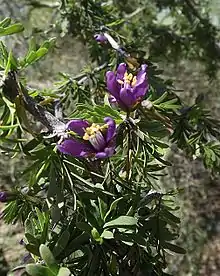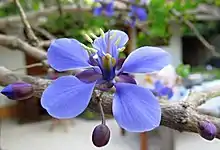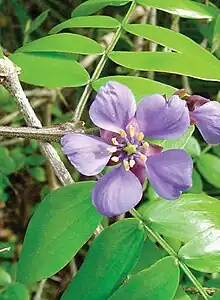| Guaiacum | |
|---|---|
 | |
| Guaiacum officinale | |
| Scientific classification | |
| Kingdom: | Plantae |
| Clade: | Tracheophytes |
| Clade: | Angiosperms |
| Clade: | Eudicots |
| Clade: | Rosids |
| Order: | Zygophyllales |
| Family: | Zygophyllaceae |
| Subfamily: | Larreoideae |
| Genus: | Guaiacum L.[1] |
| Type species | |
| Guaiacum sanctum[2] L. | |
| Species | |
|
Guaiacum angustifolium | |
Guaiacum (/ˈɡwaɪ.ə.kəm/[3][4]), sometimes spelled Guajacum, is a genus of flowering plants in the caltrop family Zygophyllaceae. It contains five species of slow-growing shrubs and trees, reaching a height of approximately 20 m (66 ft) but usually less than half of that. All are native to subtropical and tropical regions of the Americas and are commonly known as lignum-vitae, guayacán (Spanish), or gaïac (French).[5] The genus name originated in Taíno, the language spoken by the native Taínos of the Bahamas; it was adopted into English in 1533, the first word in that language of American origin.[6]
Members of the genus have a variety of uses, including as lumber, for medicinal purposes, and as ornamentals. The trade of all species of Guaiacum is controlled under CITES Appendix II.[7]
Guaiacum officinale is the national flower of Jamaica,[8] while Guaiacum sanctum is the national tree of the Bahamas.[9]
Uses

The genus is famous as the supplier of lignum vitae, which is the wood of several species in the genus. It is the fourth-hardest variety of wood as measured by the Janka hardness test, requiring a force of 4,500 lbf (20,000 N) to embed a steel ball 0.444 in (1.13 cm) in diameter half that distance into the wood.[10]
The Spanish encountered guaiacum wood when they conquered San Domingo in the sixteenth century. It was soon brought back to Europe, where epidemic syphilis had been raging for nearly a century. Gum guiacum quickly acquired a reputation as a cure for syphilis,[11] a practice Benvenuto Cellini records in his memoirs.[12] Thomas Nashe referred to its supposed medical properties in his tract Nashe's Lenten Stuff, alluding to the exotic sound of the word itself: "Physicians deafen our ears with the honorificabilitudinitatibus of their heavenly panacaea, their sovereign guiacum."[13] The detailed engraving, Preparation and Use of Guayaco for Treating Syphilis, published by Philips Galle after a design by the Flemish artist Jan van der Straet, depicts four servants preparing a concoction of gum guiacum for their wealthy master under the supervision of a physician.[14] Paracelsus, the famous if controversial Swiss physician, disputed the effectiveness of this treatment and was censured for his criticism.
Gum guaiacum was used to stimulate menstruation; in a 1793 Virginia court case, Martha Jefferson Randolph testified that she had provided gum guaiacum to a female relative to "produce an abortion",[15] suggesting that it was also used as an abortifacient. In A Treatise of the Materia Medica (1789), Scottish physician William Cullen noted: "Several physicians have apprehended mischief from the use of the guaiacum in a spirituous tincture."[16][17]
The 1955 edition of the Textbook of Pharmacognosy states: "Guaiacum has a local stimulant action which is sometimes useful in sore throat. The resin is used in chronic gout and rheumatism, whilst the wood is an ingredient in the compound concentrated solution of sarsaparilla, which was formerly much used as an alternative in syphilis."[12]
A phenolic compound derived from the resin of Guaiacum trees is used in a common test for blood in human stool samples. The presence of heme in the blood causes the formation of a coloured product in the presence of hydrogen peroxide. The effect of peroxidases in horseradish on guiacum was first noted in 1810.[18]
As a food additive, Guaiacum is designated E314 and classified as an antioxidant.
A widely used derivative drug is the expectorant known as guaifenesin.
The soap fragrance oil of guaiac comes from Bulnesia sarmientoi, a South American tree from the same family.
Members of the genus are grown in Florida and California as ornamental plants.
Species
| Image | Scientific Name | Common Name | Distribution |
|---|---|---|---|
 | Guaiacum angustifolium Engelm. | Texas Lignum-vitae | Texas, Northeastern Mexico |
 | Guaiacum coulteri A.Gray | Sonoran Lignum-vitae | Western Mexico, Guatemala |
 | Guaiacum officinale L. | Common Lignum-vitae | The Caribbean, Northern South America |
 | Guaiacum sanctum L. | Holywood Lignum-vitae | southern Florida, The Bahamas, Southern Mexico, Central America, Greater Antilles |
| Guaiacum unijugum Brandegee | Northwestern Mexico[19][20][21] | ||
Formerly placed here
- Porlieria microphylla (Baill.) Descole et al. (as G. microphyllum Baill.)
- Schotia afra (L.) Thunb. (as G. afrum L.)[20]
References
- ↑ "Genus: Guaiacum L". Germplasm Resources Information Network. United States Department of Agriculture. 2008-05-20. Archived from the original on 2011-06-06. Retrieved 2009-09-25.
- ↑ "Guaiacum L". TROPICOS. Missouri Botanical Gardens. Retrieved 2009-12-06.
- ↑ OED 2nd edition, 1989.
- ↑ Entry "guaiacum" in Merriam-Webster Online Dictionary, retrieved 2013-04-30.
- ↑ Grandtner, Miroslav M. (2005). Elsevier's Dictionary of Trees: With Names in Latin, English, French, Spanish and Other Languages. Vol. 1. Elsevier. pp. 389–391. ISBN 978-0-444-51784-5.
- ↑ Bailey, Richard W (2004). "Part I - American English: its origins and history". In Edward Finegan; John R. Rickford (eds.). Language in the USA: Themes for the Twenty-first Century. Cambridge University Press. p. 3. ISBN 978-0-521-77747-6.
- ↑ Gordon, J. E.; González, M. A.; Vázquez Hernández, J.; Ortega Lavariega, R.; Reyes-García, A. (2005). "Guaiacum coulteri an over-logged dry forest tree of Oaxaca, Mexico". Oryx. Fauna & Flora International. 39 (1): 82–85. doi:10.1017/s0030605305000141.
- ↑ "National Symbols". Emancipation & Independence. Jamaica Information Service. Archived from the original on 2011-10-28. Retrieved 2009-12-06.
- ↑ "National Symbols of the Bahamas". Bahamas Facts and Figures. TheBahamasGuide. Archived from the original on 2009-12-21. Retrieved 2009-12-06.
- ↑ Self, Charlie (2005). Woodworker's Pocket Reference: Everything a Woodworker Needs to Know at a Glance. Fox Chapel Publishing. pp. 18–19. ISBN 978-1-56523-239-6.
- ↑ Johannes Stradanus Archived 2007-11-03 at the Wayback Machine undated brief review of works. Accessed August 6, 2007.
- 1 2 Wallis, Thomas E (1955). Textbook of Pharmacognosy.
- ↑ Nashe, Thomas; Hindley, Charles (Ed.) (1871). Nash's Lenten Stuff: Containing the Description and First Procreation and Increase of the Towne of Great Yarmouth, in Norfolk: with a New Play, Never Played Before, of The Praise of the Red Herring. London: Reeves and Turner. p. 37. Retrieved 9 May 2018.
- ↑ Jan van der Straet's "Hyacum et lues venera". Accessed June 29, 2018.
- ↑ Crawford, Alan (November 26, 2000). "A House Called Bizarre". The Washington Post. Washington, DC. Retrieved May 12, 2016.
- ↑ Kierner, Cynthia (2012). Martha Jefferson Randolph: Her Life and Times. University of North Carolina Press. p. 95.
- ↑ Cullen, M.D., William (1789). A Treatise of the Materia Medica. Dublin: Printed for Luke White. p. 166. Retrieved 9 May 2018.
- ↑ Azevedo AM, Martins VC, Prazers DM, et al. (2003). "Horseradish peroxidase: a valuable tool in biotechnology". Biotechnol Annu Rev. Biotechnology Annual Review. 9: 199–247. doi:10.1016/S1387-2656(03)09003-3. ISBN 978-0-444-51400-4. ISSN 1387-2656. PMID 14650928.
- ↑ "Guaiacum unijugum". Germplasm Resources Information Network. Agricultural Research Service, United States Department of Agriculture. Retrieved 2009-12-06.
- 1 2 "GRIN Species Records of Guaiacum". Germplasm Resources Information Network. United States Department of Agriculture. Retrieved 2010-09-19.
- ↑ "Subordinate Taxa of Guaiacum L". TROPICOS. Missouri Botanical Gardens. Retrieved 2009-12-06.